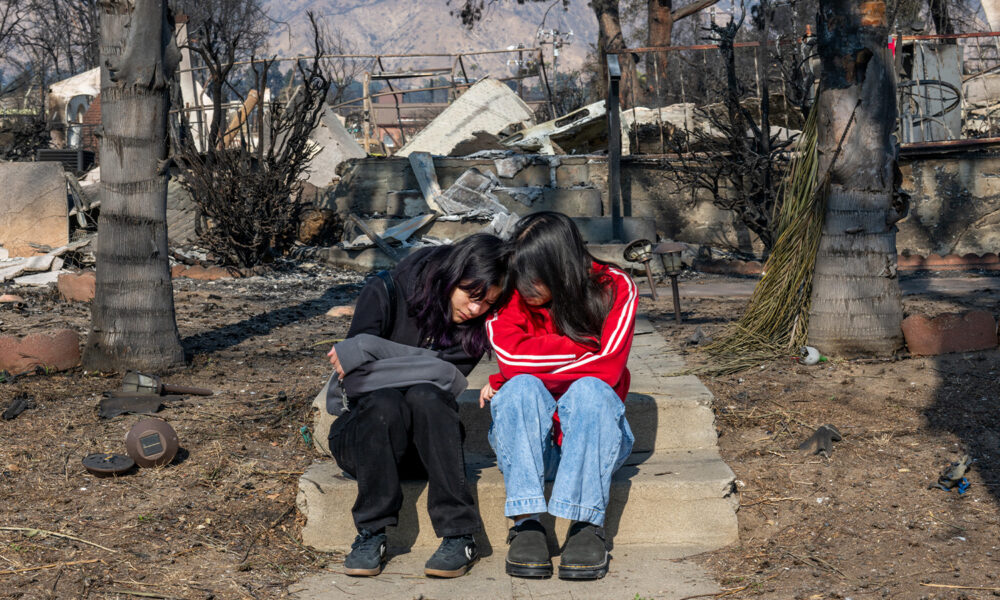Summer is considered peak wildfire season in many parts of the country, and the latest wildland fire outlook shows elevated risks in western and southwestern United States as well as Minnesota. But wildfires risks are year-round, and getting worse, as the catastrophic Los Angeles wildfires this January showed, as well as the dangerous spring fires in parts of the eastern and southwestern U.S.
Year-on-year costly wildfire seasons are now a major factor driving higher property insurance costs and limited availability of insurance in wildfire-prone areas. With climate change driving worsening wildfire risks, the future of insurance and the knock-on effects on housing affordability are major pocketbook challenges for millions of people. Yet federal policymakers are still failing to act and the Trump administration’s slashing of budgets and staffing for key federal agencies is making things worse.
Insurance markets disrupted by catastrophic wildfires
The deadly and devastating January 2025 Los Angeles wildfires, which took at least 30 lives and whose economic costs are now estimated to be as high as $131 billion, put a fresh focus on property insurance markets in wildfire-prone areas. Prior to the fires, the state had seen a number of insurers raise rates and withdraw from writing new policies, and in the wake of the fires some insurers reacted by filing for further rate increases—part of a longer-term trend in many western states. Other states, including Arizona, Colorado, New Mexico, Oregon, Texas, and Washington, are also experiencing wildfire-driven insurance challenges.
California’s insurance challenges are not new and date back to the two back-to-back 2017-2018 terrible wildfire seasons with tremendous costs that triggered a wave of insurance market repercussions that have only gathered steam since then. A “Sustainable Insurance Strategy,” launched by California Insurance Commissioner Ricardo Lara in 2023, is attempting to find solutions that work for insurers and homeowners. These reforms will certainly be tested as California is a at risk of another tough fire season this year.
US Treasury report underscores climate impacts on insurance markets
Earlier this year, the US Department of the Treasury released a report underscoring how climate-related events are leading to rising homeowners’ insurance costs and the declining availability of insurance. The report, which analyzes data trends from 2018 to 2022, shows that homeowners’ insurance rates are rising across the nation by an average of 8.7 percent above inflation. People living in the 20% of zip codes with greatest property exposure to climate risks paid 82% more than those living in the lowest 20% climate risk zip codes. The data also show that policy non-renewal rates are 80% higher in the highest risk zip codes compared with the lowest risk ones.
A key metric in the report is the Total Expected Annual Losses to Buildings from Climate Risk (TLCR), categorized by zip code across the nation and by the type of major climate-related peril. The “building value at risk” is an insurance metric for estimating the potential financial costs of damage that a property owner would face under a particular disaster scenario and usually is calculated based on costs of repair or rebuilding. Climate perils vary by region, and for the western US, wildfires are the highest source of risk. Nationwide, hurricanes account for 61.4% of the building value at risk, while severe convective storms account for 25.4%, and wildfires account for 11.7%.
Steve Koller at Harvard’s Joint Center for Housing Studies conducted a deeper analysis of insurance trends in California’s Pacific Palisades and Altadena zip codes from the Treasury Department report and found these areas already were experiencing higher than average insurance rate increases and non-renewal rates before being struck by the Palisades and Eaton fires in 2025. In other words, the warning signs were there.
An insurance crisis colliding with a home affordability crisis
The rise in insurance costs is one more factor contributing to the rising costs of home ownership nationwide, and it’s especially acute in places that have experienced repeated climate-driven disasters. Year-after-year rate shocks, limiting of coverage and outright withdrawal of insurance are now commonplace realities for all too many people.
From 2021 to 2024, annual homeowner insurance premiums have increased an average of $648 across the country, a 24% increase that is 11% higher than inflation across that period, according to a report from the Consumer Federation of America. The report cites “rising costs of construction and building materials, climate change, an expensive and tight global reinsurance market, and weak regulatory oversight by state insurance commissioners” as the main factors behind these increases.
Many are increasingly turning to so-called residual markets—the state Fair Access to Insurance Requirements (FAIR) plans —which serve as insurers of last resort providing high-cost bare-bones insurance for those unable to procure it through the traditional private market. These plans, which are state-run and backed by a pool of private insurers, provide limited coverage with much higher premiums, a last resort for homeowners shut out of the regular market.
Data show that California’s FAIR plan is taking on an increasing number of policies, with the percentage of these policies rising to 3.7% of the market in 2023 from 1.7% in 2015. In the top ten counties with homes at high wildfire risk, that figure reached 32.6% in 2023. And since then the numbers have only grown, with the number of FAIR plan policies rising by 23 % between September 2024 and March 2025. Colorado just launched its FAIR plan in April as a result of homeowners finding it increasingly hard to get insurance as wildfire risks there grow.
And it’s not just single-family homeowners feeling the impacts—the rising costs of insurance are also affecting multi-family housing, undermining the ability to maintain affordable housing. In some cases, the costs are also being passed through to renters.
Worst of all, many people find themselves temporarily or even permanently displaced from their communities after catastrophic wildfires. Returning can be impossible if insurance claims are denied or if there is no or insufficient insurance to rebuild. And returning to a place that is at high risk of wildfires can be dangerous—although leaving for a new place can be incredibly expensive and wrenching. For people with few or moderate resources who find themselves on the frontlines of these climate-fueled wildfires, the choices are hard and getting harder.
Greater oversight of insurance companies needed
Regulators must also pay greater attention to examining the underlying reasons for the rate increases and not simply take insurance companies’ rationale at face value. Even as insured losses grow, major insurance companies are still largely maintaining healthy profits through their business model of generating earnings off premiums. As the Consumer Federation report states:
It is important to note—and insurers often fail to acknowledge this when reporting rising claims costs—that insurance companies earn a significant portion of their profits by investing customers’ premiums and the surplus capital they hold. Instead of acknowledging the nature of the business model, insurers point to low “underwriting profits” or underwriting losses as a justification for rate increases. But since the underwriting profit excludes investment income it fundamentally misrepresents the profitability of the business.
Insurance companies are also being called out for failing to pay up, or delaying payments, in the wake of disasters. California Insurance Commissioner Lara has just launched an investigation into State Farm’s handling of insurance claims from the fires. The “Market Conduct Examination” comes as a result of numerous consumer complaints about State Farm and will look into whether the company complied with state laws and whether additional reforms are needed. This kind of oversight, transparency and enforcement is urgently needed, especially as climate-fueled disasters are increasingly disrupting insurance markets and leaving people at the mercy of arbitrary decisions by insurance companies even as they deal with the trauma of losing their homes.
Meanwhile, egregiously, insurance companies are continuing to insure fossil fuel projects and infrastructure—the root cause of the climate crisis! As UCS research shows, major fossil fuel producers bear a huge responsibility for the emissions that are fueling worsening western wildfire seasons.
A future of cascading climate risks to insurance and home markets…
A recent Senate Budget Committee report on the climate-driven insurance crisis contains a stark warning that encapsulates what the future could bring:
As climate change gets worse, so does trouble in insurance markets, threatening mortgage markets and property values. In certain communities, sky-high insurance premiums and unavailable coverage will make it nearly impossible for anyone who cannot buy a house in cash to get a mortgage and buy a home. Property values will eventually fall — just like in 2008 — sending household wealth tumbling. The United States could be looking at a systemic shock to the economy similar to the financial crisis of 2008 — if not greater.
Furthermore, when homeowners struggle to procure mortgages or insurance and if property values decline, local tax bases also suffer, and municipal bond ratings can also decline. That could put communities in a difficult bind, making it harder to fund local amenities and infrastructure.
…Or a climate-resilient future
The reality is that with climate change escalating wildfire and other risks so significantly, it will be hard to stabilize insurance markets everywhere for the long term. Insurance can at best be viewed as one tool that must be complemented by holistic solutions—including ramping up investments in climate resilience, limiting heat-trapping emissions, and creating more affordable housing in safer places.
Homeowners should be on the alert and do everything they can to prepare. States and local jurisdictions can and must do a lot to support and advance these efforts. Investments in firefighting using the latest technologies and a fairly compensated wildland firefighting workforce, as well as in managing forest ecosystem health, are all crucial. Insurers must play a role too in providing incentives for investments in fire-proofing homes, and making communities more resilient to fires. But these efforts will fall short without support at the federal level.
That brings us back to the Trump administration, where the president’s latest executive order aimed at addressing the rising dangers of wildfires raises some skepticism, given the budget cuts to federal agencies like NOAA, that helps with wildfire mapping and warnings, and FEMA that helps with response and recovery—not to mention the administration’s refusal to acknowledge the role of climate change in contributing to worsening wildfires and its actions to boost of fossil fuels.
Congress must step up to do its part to move forward bills that invest in mitigating wildfire risks and helping communities become more wildfire-resilient. Communities also need true solutions to the insurance crisis, solutions which recognize its intersection with the climate and housing affordability crises. I’ll be writing more about what these solutions could look like in future blogposts.

